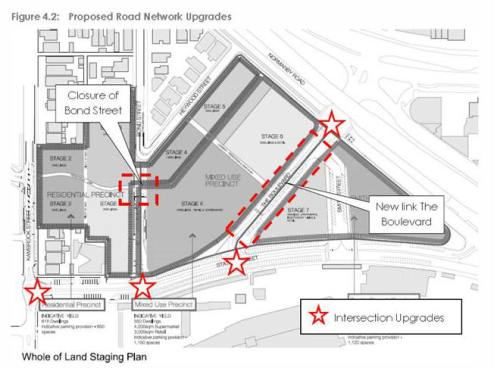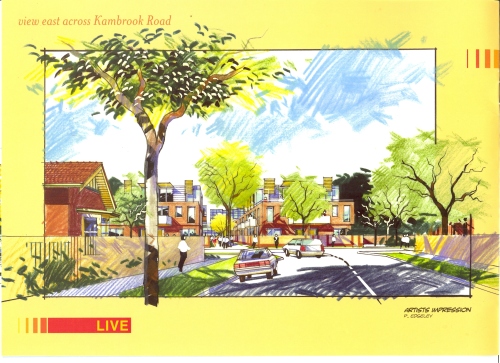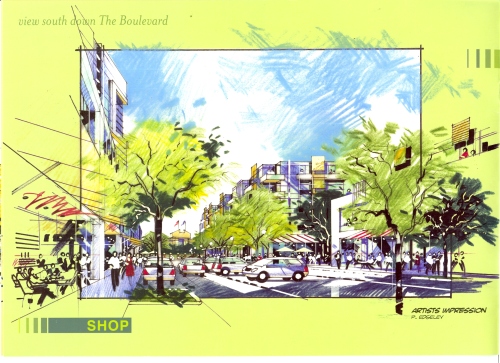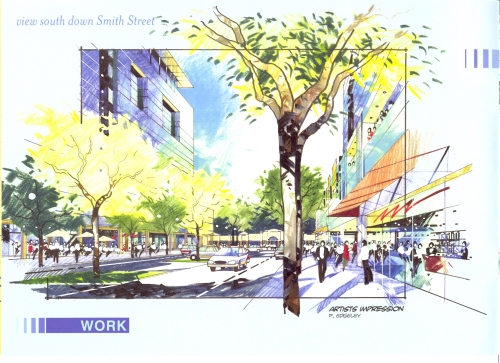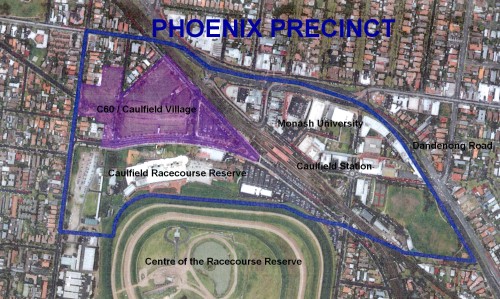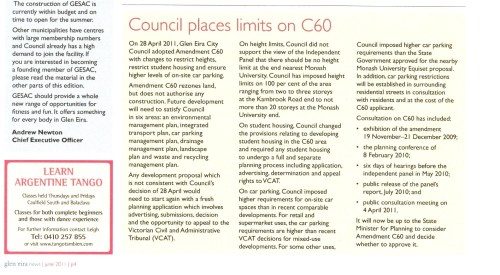This posting is a continuation of our previous posting “Part 2 – C60/Caulfield Village Development Plans – Why you can & should object – Traffic”. If you haven’t already done so, GERA recommends reading this posting in conjunction with our earlier C60/ Caulfield Village Development Plans postings.
Overview
Picture and Documentation
Part 1 –Why you can & should object
Part 2 – Why you can & should object
***************
Traffic – continued
• Infrastructure changes – The Integrated Transport Plan, under the S173 agreement*, proposes the following infrastructure changes to the existing, analysed road next work.
Details of the “starred” infrastructure works are
These modifications will be undertaken as appropriate for each stage of the Development (eg. signalisation of the Kambrook Road/Station Street intersection will occur during the Stage 2 construction phase).
Parking
As previously mentioned in our Overview posting residents have consistently raised issues with inadequate parking provisions within the development. These issues have been
• Inadequate consideration given to displaced parking in Smith Street, Station Street and ‘the triangle’ on weekdays or during Racecourse events. Displaced parking arising not only from road configurations but also by the introduction of time restricted parking within the development have not been considered.
• Impact of development on surrounding limited open space (use of the Centre of the Racecourse Reserve as a car park)
• No consideration given to the parking impact of the Monash University development on the C60 development or surrounding residential areas.
• No consideration given to the “Triangle” displaced parking (shared by Monash University staff and Tabaret (“Glasshouse”) patrons.
• Inadequate on-site/off-street visitor parking provision
Council has long recognised that on street parking demand in the local area exceeds demand, particularly during weekdays and racecourse events.
• The weekday demand for parking is predominantly due to the proximity of Caulfield Station and commuters seeking on street, paid all day parking (Smith Street, Station Street, and Normanby Road) or unpaid on street all day parking in residential streets. Parking demand arising from Monash University primarily arises from students and is directed to residential streets.
• Parking demand for Racecourse events is currently provided
o Off Street – by the Centre of the Racecourse (3000 free public parking accessed by the Glen Eira/Booran Road Tunnel), Members Carparks 1 & 2 (not available post development), the Guineas Carpark (536 space – crown land) and the Kambrook Road (674 spaces – MRC free hold land). In total existing carparking will decrease 5646 spaces to 4210 spaces post development..
o On-street – along the main roads (Smith and Station Streets, Kambrook and Normanby Roads) and surrounding residential streets.
Residents should note that a review of both the Car Parking Management Plan and the Integrated Transport Plan shows
• No provision for on site/off street visitor parking
• On site/off street car parking provisions within the development are 2910 basement or podium car spaces with secured access. Analysis of provisions shows an excess of 333 spaces which, since this falls short of the required 409 visitor parking requirement imposed by Council and is located in secured access areas, residents assume is included to provide flexibility for future stages (Stages 2 & 3) of the development (eg. increased retail/commercial, decreased dwellings)
• 165 current of on-street/off site car parking spaces will be lost due to the reconfiguration of Smith and Station Streets and lower on-street/off site parking provisions in the Boulevard.
• Of the expected 18,900 vpd traffic generated by the Development, 8,500 is attributed to residents (presumably accessing or exiting the development) and 10,400 vpd is attributed to retail. Even allowing for the short term, high turnover requirements of retail parking on street parking provisions are inadequate.
• Inadequate analysis is provided for displaced car parking on major event days (e.g Caulfield Cup), eg. use of Centre of the Racecourse for Members Parking displaces public parking)
• The Caulfield Village has not been excluded from the residential parking permit scheme nor has any comment been made on the
o introduction of timed parking restrictions in local residential streets (as per the media release, cost to be paid by the MRC) or
o the implementation of enforcement procedures in the local residential streets
Open Space
Discussion on open space provisions within the provided documentation is scant and indicate that
• within the development, public open space needs are provided solely by linear, landscaped access paths (some shared with vehicle garage access) which are said to foster a “vibrant community”. However, residents have indicated that the proposed landscaping provides for small, sparse canopy trees that will have difficulty surviving in soil depths limited by basement car parking and locations between multi-storey buildings that restrict access to sunlight and rainfall. In addition residents suggest that linear parks are generally seen as serving little civic purpose or function as they are more suited to movement than congregation.
• In general little mention has been made of parks within the surrounding area (Centre of the Racecourse, Caulfield Park, East Caulfield Reserve), while that mentioned focuses on “already at capacity” Caulfield Park. Yet, the Centre of the Racecourse closer to the development and is within easy walking distance of any point within the development. Additionally, improved pedestrian connectivity to East Caulfield Reserve has been overlooked.
Drainage
Several of our members with knowledge of drainage (GERA does not profess to be drainage experts) have expressed concerns on the storm water drainage provisions outlined in Development Plan documentation. Their concerns arise from a 90% impermeable site coverage (previously 100% permeable), the increasing frequency of extreme weather events and a natural land slope that will direct surface run off towards Caulfield Park. While Council is currently undertaking drainage works in the nearby residential streets (presumably to service the drainage requirements of the C60/Caulfield Village Development), our members are also concerned that, as in the last extreme weather event, increased storm water flows where Council drains connect with Melbourne/South East Water drains may result is flooding in areas removed for the actual development site.
Public Transport Infrastructure
GERA, like most residents, is not anti-development, we recognise
• that population growth requires additional housing (of diverse types, in various locations with access to public transport), and
• that there is considerable intrinsic value in encouraging use of sustainable transport options (walking, cycling and public transport) vs. use of private motor vehicles, and
• that the above two points places a responsibility on all levels of government to adequately provide those sustainable transport options.
Unfortunately, the development of, or improvements to the most expensive (and perhaps most effective) sustainable transport options – public transport – are lacking. Without service and capacity improvements to the current inadequate, stretched to capacity public transport network, developments of the magnitude of C60/Caulfield Village do more to encourage the use of private vehicle transport than it does to encourage the use of public transport. For this reason GERA believes that C60/Caulfield Village proposal should be delayed until public transport infrastructure improvements are at least in the pipeline.
—————–
Since the submission deadline is 26th February, 2014 (the date of this posting), those readers who have yet to make a submission to do so a.s.a.p. as the Planning Conference is to be held on
Monday, 3rd March, 2014 at 6.30 p.m. at the Caulfield Park Pavilion
Council MAY accept late submissions and if so, given the limited time frame, we encourage sending submissions via email. A submission does not have to lengthy and it does not require your attendance at the Planning Conference. However, it does place your submission on record and ensures that Council will inform you of it’s decision.
Residents who have not made a submission may still attend the Planning Conference.
**********
* Section 173 Agreement
Broadly, a Section 173 Agreement is a legal agreement (under Section 173 of the Planning and Environment Act 1987) between the Local Authority (Council) and the owners of the land (the MRC in this instance). S173 agreements are generally used to reinforce planning controls and impose restrictions and conditions on titles.
Declaration
Please note GERA advises that a number of our members reside in the vicinity of the C60 / Caulfield Village Development – the number of these members is less 0.5% of the 500 local residents that Council has identified, and contacted, as those most likely to be impacted by the development. This percentage falls further when the development’s flow on impacts to the broader community are considered.

